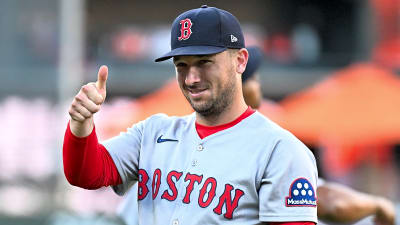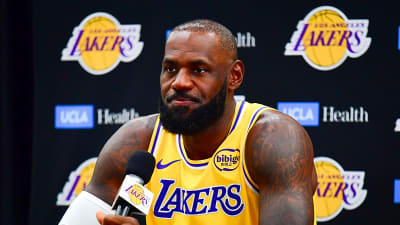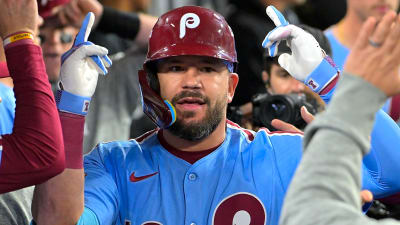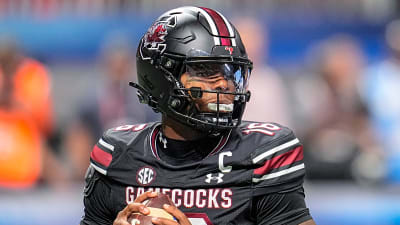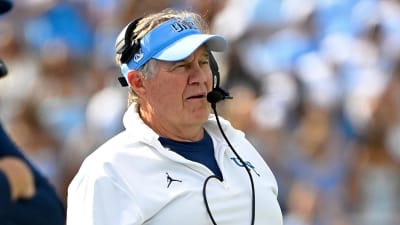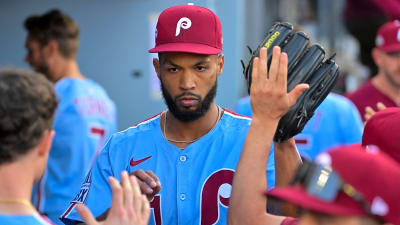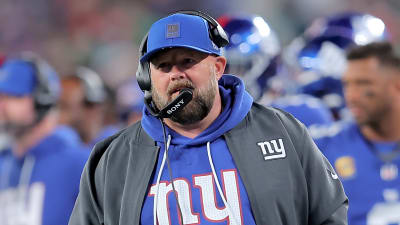As we wrap up the countdown of the Greatest Huskers by the Numbers, it's worth pointing out that the single biggest criterion for consideration was to have worn a jersey with a number on it. Even with a very basic minimum requirement, there were players who were left out.
Nebraska's first season was in 1890. Over the next 37 years, only two teams - 1921 and 1925 - had uniform numbers listed on the roster before numbers were used full time starting in 1927. Unfortunately, that means approximately 360 Cornhusker, Bugeater and Old Gold Knight players were unable to be considered for recognition.
These founding players deserve the spotlight too.
Nebraska was a winner from the start, going a perfect 2-0 in its inaugural season. In the 35 seasons they played without numbers on their uniforms, only two ended with a losing record (1899 and 1918). Nebraska won 15 conference titles in the numberless era.
The stars of those early teams are largely forgotten legends. Thirty-two of them earned first-team all-conference honors.* Twelve have been inducted into the Nebraska Football Hall of Fame.
*As a reminder, Nebraska spent 13 of its first 31 seasons as an independent team. This is a big reason why a program that went 174-60-15 (.729) between 1890 and 1920 has "only" 12 conference titles to show for it.
In 1936, the members of Sigma Delta Chi, a professional journalism fraternity, sought to name the 11 best players in school history. They mailed postcards to 300 Nebraska football alumni asking them to name the best player at each position. From the responses, they formed an all-time, all-star team which was published in a special section in the Daily Nebraskan.
The names of first- and second-team players who never wore a Nebraska uniform with a number on it:
- Guy Chamberlain
- Max Towle, quarterback
- John Bender, halfback*
- Maurice Benedict, quarterback*
- Dick Rutherford, left halfback
- Leo Scherer, right end
- John Westover, left tackle
- E.L. Abbott, left guard
*If those names sound oddly familiar, don't be surprised. John Bender and Maurice Benedict were stars of the 1905 team that inspired the song "The Cornhusker," commonly known as "Come a Runnin' Boys." Earl "Doc" Eager was a halfback on those teams.
Here is the verse that references them:
In the days of old
Johnny Bender bold would just take that ball in hand
And with Benedict right in front of him
They would set sail for the land
Then Doc Eager too with a chosen few
Would be all round everywhere
And before they’d quit, they would calmly sit
Down behind that goalpost there
The greatest Husker without a number is Guy Chamberlin.
We briefly touched on "Champ" Chamberlin's Cornhusker career back at No. 38.
Chamberlain, who began his career across town at Nebraska Wesleyan, was one of Nebraska's first "transfer portal" success stories. The pride of beautiful Blue Springs, Neb., was all-conference in each of his two seasons at Nebraska. He was just the second player in school history to be named a first-team All-American.*
*Vic Halligan, a tackle from North Platte, Neb., was the first Cornhusker All-American. He earned his honors in 1914, one year before Chamberlain.
Chamberlain was a star of Ewald "Jumbo" Stiehm's best teams. The press called them the "Stiehmrollers," and they lived up to the name. The 1914 squad went 7-0-1, winning the Missouri Valley Intercollegiate Athletic Association (MVIAA) title. In 1915, Nebraska went a perfect 8-0, winning another MVIAA crown and beating Notre Dame in the first game of an 11-year series. In his final college game, Chamberlain scored four touchdowns against Iowa in a 52-7 victory.
The 1915 Cornhuskers foreshadowed the team that would follow them 80 years later. They averaged 35 points per game and shut out five of their eight opponents. In 1965, the Billingsley Report named the Nebraska Cornhuskers as the national champions for 1915.*
*Nebraska does not claim this title. A different Big Red (Cornell) and Pittsburgh claim the 1915 national championship.
Guy Chamberlin is one of three Cornhuskers (along with Bob Brown and Will Shields) to be inducted into the College and Pro Football Halls of Fame. In the Sigma Delta Chi poll of former players, Chamberlain appeared on the most ballots and was named the greatest player in Nebraska's first 45 seasons.
Other great players from the pre-numbers era include Oren "Buck" Beltzer, John Cook (an all-conference QB in 1917), Tim Corey, George Flippin, Owen Frank, the Hubka brothers (Ernest, Ladimer, and Ladas), Ernest Kroger, Ebenezer Mockett, Grove Porter, Roscoe Rhodes and Sylvester Shonka.
I wish I many of these players from the first era of Nebraska football could have been included in the countdown. It would have been fun to learn and share some of their stories.
* * *
I'm really pleased with how the selection process of the 100 "Greatest Huskers" turned out. With a few exceptions - notably, 55*, 12, and 3 - I didn't get a lot of pushback on who was - or was not - chosen. I freely admit I avoided the hardest choice at 75 by going with "co-greatest" picks.
*A certain former owner of the "double nickel" reached out to share his disappointment with my pick. I respect his opinion, but I'll stand by the methodology I set out at the beginning.
The biggest difference between this project (naming the greatest Husker to wear each jersey number) and a true "these are the 100 greatest players in school history" list is that my approach included some players who… how do I phrase this politely?... had less than legendary careers.
Johnny Rodgers at No. 20 was a slam dunk pick. Ditto for Dave Rimington at 50 and several others. But there were some digits where the pickings were slim and/or underwhelming. I can think of a couple of picks who probably wouldn't make a top 20 list of players at their position. But that's okay! Part of the fun was remembering some guys who we don't think about that often.
* * *
During the countdown, I received a great question from an old friend:
"Which numbers are most likely to see a change in the next few years, or in the future?"
If I - or somebody else - were to revisit this project in 10 years, which number(s) are most likely to change? This is actually the second time I've taken on this project. Back in 2013-2014, I did the greatest players from the first 50+ years of the Memorial Stadium sellout streak era, which started in 1962. As I noted at No. 8, Ameer Abdullah played himself from honorable mention into a no-doubt pick. So, it is definitely doable.
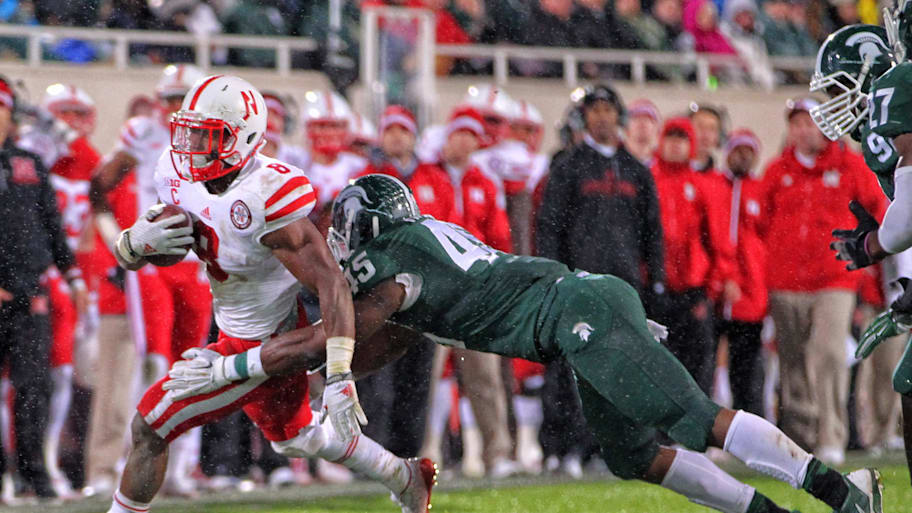
There are a handful of numbers (7, 15, 30, 34, 50, 54, 71, 72, 75, 79, 93, 98) where a player would need to win a major award or two just to enter the discussion. I feel confident the majority of these will stay the same for years to come.
But on the flip side, there are several digits where, frankly, it wouldn't take much to supplant the person who is there.
At the top of the list are the five numbers without a first-team all-conference selection: 0, 16, 49, 83 and 97.
With one or two exceptions, earning first-team all-conference status was a minimum requirement for consideration as a "greatest" player. I believe it is unequivocally harder to earn first-team status in an 18-team league than it was in the Big Eight days. If somebody at those five numbers gets onto the second team, I'd be tempted to give him the title.
Zero is interesting because it has the smallest pool of candidates. Javin Wright is just the sixth Husker to wear that number. But with 0 being a part of Matt Rhule's "single digit" tradition, it is less likely to have a player wearing it for the bulk of his career.
Looking at the players on the 2025 roster who could potentially challenge for Greatest status at their current numbers:
- Dylan Raiola (15) absolutely has the talent, but he would need some serious hardware (and possibly a ring) to beat out Tommie Frazier.
- If Jacory Barney Jr. (2) continues to develop as a punt returner, he could become a candidate for the Jet Award. Winning a national award is an express ticket to "Greatest" status.
- Keona Davis is a talented young player at a one of the numbers (97) where "greatest" has a low bar.
- Freshman Australian punter Archie Wilson (83) falls into the same category. It's wild - and admittedly unfair - to speculate about him making a "greatest Huskers" list so early in his first season of American football. But his ceiling is extremely high.
Beyond that, I can point to a dozen or so digits that could be ripe for a takeover in the coming years or decades.
That's the beauty (and the fun) about lists like this: they are always changing and evolving. They're meant to inspire debate and "oh man, do you remember how good this guy was?" memories.
* * *
Throughout these posts and pages, I've been seeking the answer to what should be a very simple question:
How in the heck did Nebraska become one of the great college football programs, with an unparalleled run of success that lasted more than 40 years?
Think about it: Nebraska is a small-population, landlocked state without a deep recruiting footprint. In the 150+ year history of college football, no national champion has come from a state smaller than Nebraska. It defies logic that Nebraska was - and still is - one of the true blue bloods of the sport.
How did it happen? And more importantly to today's fans: How can Nebraska get back to that point?
Everything we've covered - the players, the coaches, and games, the moment, memories, and mayhem, all of it - has been an attempt to answer that fundamental question.
Here's the answer:
There was no one single thing that moved Nebraska from a perennial loser after World War II into decent program in Bob Devaney's first years into a multi-decade run of dominance. The answer is so much more complex than "Nebraska hired Bob Devaney and the rest is history." It ignores the real reasons why Nebraska football did what it did for as long as they did it.
Nebraska's rise under Devaney (and sustained excellence under Osborne) was made up of numerous small streams and tributaries: recruiting, great (and loyal) assistant coaches, offensive system, strength training, black players, TV access, training tables, academic excellence, the walk-on program, patient development, four practice stations, the Unity Council and so much more. All of these seemingly separate things converged into a mighty river that would flow deep and wide, washing over anything in its path.
The common thread for all of these is innovation. Nebraska - a tiny-population state in a wide-open part of the country, surrounded by other tiny-populated, wide-open states - was never going to win by signing the 25 best high school boys from the state and plugging them into a flavor-of-month system led by coaches who weren't interested in putting down roots.
No, for Nebraska to win - at all, let alone at the sustained level they did under Devaney and Osborne - took innovation. They had to find the untapped advantages hidden in the nooks and crannies of the sport. Then, they had to have the courage to buck conventional wisdom and dive in head first.
Nebraskans have shown a pioneer spirit since the days when buffalo outnumbered humans. But being a pioneer can be a lonely journey full of doubt, second-guessing, and the knowledge that there is safety in numbers.
Continuity of staff - and of purpose - was mission critical from the turning point at the end of the 1968 season where Devaney faced a sink-or-swim moment. Yes, the offense and defense systems changed and evolved over the years. But the underlying principles remained the same.
If you want a quick answer for why Nebraska has been largely unsuccessful since Osborne retired, I'll give you three.
- Nebraska has - as a whole - done a horrible job of hiring head coaches since December 1997. Some won games, but nobody built anything stable or lasting. (I'm intentionally excluding current head coach Matt Rhule from this, as it is too soon to judge his tenure).
- All of Nebraska's innovative edges from the Devaney and Osborne eras are gone. For the last 30+ years everybody has had a gigantic weight room (often run by a Boyd Epley disciple). Darn near every FBS game is on TV. Recruiting is a full-fledged industry where "diamonds in the rough" are few and far between. Most players are not interested in redshirting, let alone being practice squad cannon fodder for multiple seasons before cracking the lineup and hopefully starting as a senior. Hell, most players would have transferred before I finished typing that sentence. Rules and regulations have been put in place by conferences and the NCAA to break up the monopolies and even the playing field. Roster limits and the rising costs of a college education mean that players who once would have walked on at Nebraska are now taking scholarships at smaller schools. There are more examples, but I think you get the point.
- Success can breed success, but complacency is the enemy of great. Think about the amazing run Nebraska had in the 1990s. Three national championships in four years! Sixty wins and just three losses! That didn't happen overnight. It was a progression of building upon what had been there before. Now think about how the program seemingly fell off of a cliff at the end of the 2001 and in 2002. The level of recruiting had fallen off. Some of the long-time assistant coaches whose loyalty was rightfully trumpeted as a reason for success were nearing the end of their careers and didn't have the same drive. An attitude of "we're Nebraska, of course we'll be great" eroded the foundation of hard work and innovation.
The current era seems to be more about who has the largest checkbook than who is the best at identifying, recruiting, developing and utilizing talent. Nebraska's current place in one of the two richest conferences matters a lot, but NU's population (and alumni) base is small in comparison to most of their Big Ten peers. Despite being home to one of the world's richest men (whose many local investors have also amassed small fortunes), Nebraskans tend to be a fiscally conservative bunch. We'd rather save our money than spend it on something with a low rate of return.
The right hires - the head coach, his coordinators and assistants - are vital to the day-to-day success of the program. We've all seen what can happen when a poor and/or inexperienced coach has the keys to the castle. Leadership matters too. I'm not suggesting that everybody from the Nebraska university system president on down (Board of Regents, chancellor, athletic director, etc.) needs to prioritize football over everything else. Frankly, that's not a great way to run a university. But having a common goal - and avoiding petty political in-fighting - matters a lot.
Finally, it is critical that the key stakeholders on the periphery (the big boosters, prominent alumni, and others whose voices carry a lot of weight) put their egos aside for the good of the program. Most fans can think of some pivotal moments where somebody's pride or the stubborn belief of "that's not the way we've always done it" has held this program back. I intentionally passed on a few opportunities to call these out, as I wanted our journey to be a positive one.
It's foolish to think there is just one path back to prominence. Tom Osborne proved Nebraska can be a perennial championship contender with offenses that threw it, ran, it and were balanced, so any belief that the Huskers can only win by one specific system is short-sighted. I really like the approach current head coach Matt Rhule is taking. He clearly has a plan - based upon his previous successes - and he's not looking for shortcuts or quick fixes. I have confidence in his ability to get Nebraska back to respectability.
Nebraska probably will never win three championships in four years again, but the Huskers can absolutely become a force on the national stage. To do it, they'll have to continue to look in the margins for competitive edges, grab them first, and use them to pull the program up to where fans want it to be. Once there, they cannot coast or rest on their laurels. EVERYBODY wants to win, and many teams (or boosters) are willing to do (or spend) whatever it takes to get on top.
And if for some reason it does not work out, we'll dust ourselves off and keep trying. That's what this program has been doing for over 135 years.
Thank you for joining me on this journey.
More must-reads:
- Urban Meyer offers bold take on Penn State's James Franklin firing
- Curt Cignetti contract should keep Indiana relevant in Big Ten for foreseeable future
- The 'Oldest starting QB by NFL team' quiz
Breaking News
Trending News
Customize Your Newsletter
 +
+
Get the latest news and rumors, customized to your favorite sports and teams. Emailed daily. Always free!
